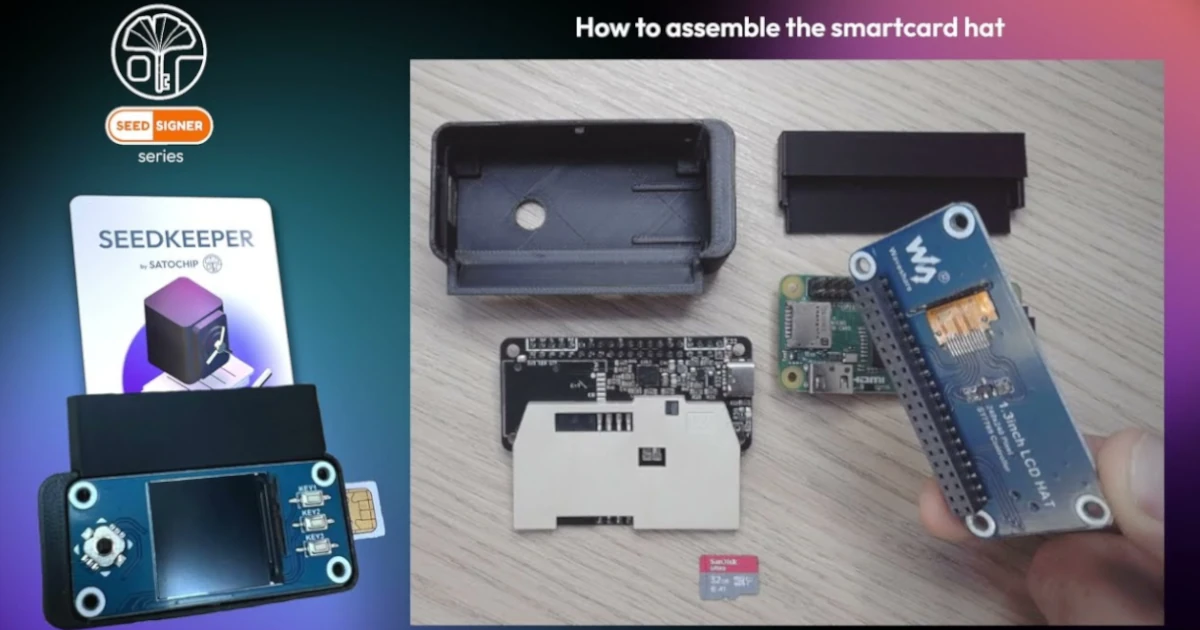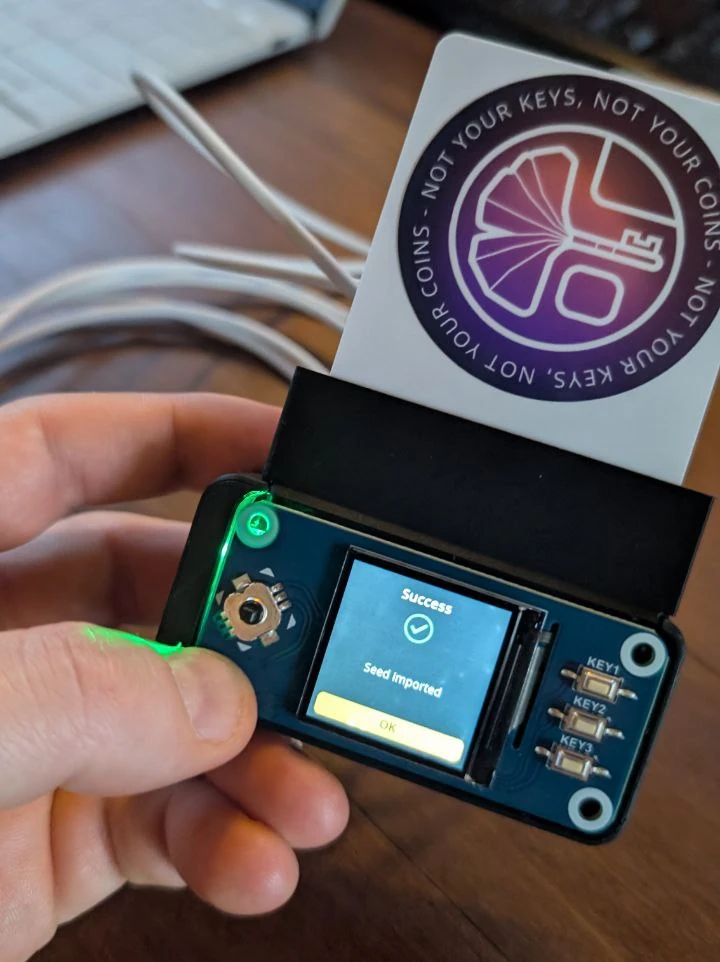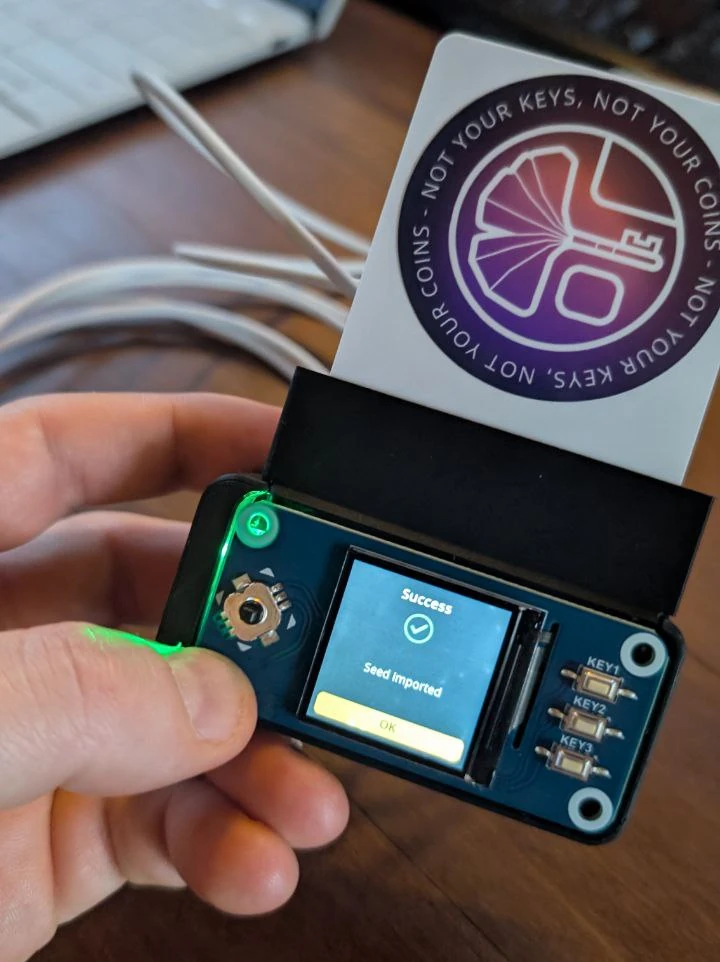Bitcoin Magazine

Build Your Own Hardware Wallet? Seedsigner + Satochip Combo is Nuts
Did you know you can build your own hardware wallet? I recently attended a workshop with Dani @bitcoineando, a Bitcoin evangelist and software engineer who will be hosting a workshop on just this topic next week in Adopting Bitcoin, El Salvador. The whole process took less than an hour and took me from having never assembled a small hardware device of this sort, to a fully configured and self-assembled Bitcoin Seedsigner and smart card backup combo via the Satochip suite.


For those attending the now historic Adopting Bitcoin conference coming up this month in El Salvador, the free workshop will take place on Friday, November 14th at 3:50-4:50 pm, in the English Workshop room and will be delivered in both English and Spanish. Attendees who bring a laptop and go through the full workshop will get a free Seedsigner + Satochip combo to take home, plus the knowledge of how to build the whole thing themselves. Sign up here to lock in a limited spot now.
What’s amazing about the combination of these two great open source projects is that they are made of very common hardware that can be purchased almost anywhere in the world. No specialized hardware from artisan manufacturers, this is a pure DIY project that can be a viable option for users in developing nations with tight import controls, under oppressive financial regimes, under a tight budget, or just those paranoid enough to want to build everything themselves.
SeedSigner
The SeedSigner project launched in December 2020 and empowers users to build their own affordable, air-gapped Bitcoin transaction signing device for more or less $50 using off-the-shelf components like the Raspberry Pi Zero v1.3, a camera module to scan QR codes, and a small LCD display to verify transactions and navigate the menu with a small joystick and three buttons.
Created by a pseudonymous founder known simply as “SeedSigner,” today supported by a growing community of contributors and led by Kieth Mukai, the project emphasizes trustless private key generation and supports a wide range of toolin,g such as BIP39 seed phrase creation via dice rolls, seamless integration with multisig wallets like Sparrow, Specter, BlueWallet, and Nunchuk, among others.
SeedSigner is fully Free and Open Source Software (FOSS) released under an MIT license for the core code. All hardware specs, software, and enclosure designs are publicly auditable on GitHub, allowing anyone to verify, modify, or build from source for maximum transparency and community-driven improvements.



While Raspberry Pi Zero’s CPU/GPU firmware and bootloader are proprietary and closed source software from Broadcom provided by the Raspberry Pi foundation, the design of the Seedsigner optimizes around managing those risks, such as letting the user provide their own entropy, and opting for no wireless communication modules like Bluetooth. Seedsigners are also “stateless”, designed to have no memory storage, instead booting fresh every time and requiring the user to input the seed that is used in the same session to sign transactions.
These security measures make the SeedSigner a popular hardware device for enthusiasts and advanced users; however, it presents some unique user experience challenges. Critics and competitors of the SeedSigner argue that manually inputting 12-word seeds into the device via key input or by scanning QR codes of private key backups puts user funds at risk, as it exposes the key material to cameras, which are ubiquitous in today’s digital age. The process can also be tedious and presents a user experience friction that stateful hardware wallets do not have, which is what makes SeedSigner’s collaboration with Satochip smartcards so special.
Satochip
Satochip, a Belgian startup founded in 2014 by Baudouin Collard and Bastien Taquet, focuses on affordable, open-source smartcard-centric hardware wallets. Their flagship products — Satochip (NFC hardware wallet), Satodime (bearer card), and Seedkeeper (a kind of password manager) — work with wallets like Sparrow and Electrum. Their Java Cards project is an open-source (AGPLv3) applet that turns cheap smartcards (e.g., YubiKey, SIMs) into secure, DIY BIP39 hardware wallets with EAL6+ security.
Taking a different approach to crypto key security, smartcards are stateful and store key material in encrypted formats, using some of the most advanced security chips in the market, often better than the technology used by credit cards and bank debit cards. The smartcards are NFC-enabled, leveraging the same near field communication technology that much of the world is used to today. An antenna that, while ranged, is considered so limited in its distance that advanced hardware wallet manufacturers like CoinKite have also integrated it into their highest-grade hardware wallet, the Coldcard Q.
The main downside of the smartcard approach to crypto security is the lack of a screen, which is needed for users to verify what they are signing. Satochip thus integrates with various mobile and desktop apps, as well as its own apps available on Android and iOS.
SeedSigner is also now deeply integrated with Satochip, allowing users to flash the new smartcards directly from the SeedSigner, improving the experience of setting up the wallet, while also supporting a smartcard reader hardware expansion.
The combination of these two open source projects seems like a match made in heaven, as users can now leverage the open source, consumer hardware nature of the SeedSigner, with the seed backup and ease of use nature of the smartcards, arguably improving the security and user experience of both projects.
One of the very valuable skills of the workshop, its corresponding website, and how-to guide teaches how to verify the authenticity of software installed on the hardware. Both the Seedsigner and Satochip applets are signed by the developers with their PGP keys. A hash or unique cryptographic ID of the software is created using an algorithm like SHA-256 (used also in Bitcoin mining) resulting in a string of digits, this string is unique to the exact software used to generate it — if one letter in the software is changed, the hash changes completely.
That hash is then signed by the developers with their PGP keys, which produces another unique and deterministic blob of data. The result is a chain of software signatures that ultimately let users know a known and reputable developer is acknowledging a specific software release as legitimate and authentic.
Knowing how to do this kind of verification can seem daunting at first, but it is actually quite easy and stands as the root of cypherpunk values and sovereignty in the digital age.

This post Build Your Own Hardware Wallet? Seedsigner + Satochip Combo is Nuts first appeared on Bitcoin Magazine and is written by Juan Galt.
from Bitcoin Magazine
Juan Galt



0 Comments